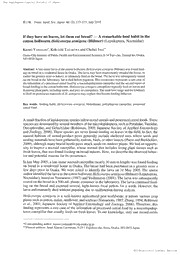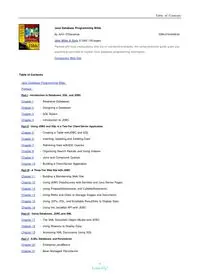
Java Database Programming Bible PDF
Preview Java Database Programming Bible
Table of Contents i Java Database Programming Bible by John O'Donahue ISBN:0764549243 John Wiley & Sons © 2002 (702 pages) Packed with lucid explanations and lots of real-world examples, this comprehensive guide gives you everything you need to master Java database programming techniques. Companion Web Site Table of Contents Java Database Programming Bible Preface Part I - Introduction to Databases, SQL, and JDBC Chapter 1 - Relational Databases Chapter 2 - Designing a Database Chapter 3 - SQL Basics Chapter 4 - Introduction to JDBC Part II - Using JDBC and SQL in a Two-Tier Client/Server Application Chapter 5 - Creating a Table withJDBC and SQL Chapter 6 - Inserting, Updating,and Deleting Data Chapter 7 - Retrieving Data withSQL Queries Chapter 8 - Organizing Search Results and Using Indexes Chapter 9 - Joins and Compound Queries Chapter 10 - Building a Client/Server Application Part III - A Three-Tier Web Site with JDBC Chapter 11 - Building a Membership Web Site Chapter 12 - Using JDBC DataSources with Servlets and Java Server Pages Chapter 13 - Using PreparedStatements and CallableStatements Chapter 14 - Using Blobs and Clobs to Manage Images and Documents Chapter 15 - Using JSPs, XSL, and Scrollable ResultSets to Display Data Chapter 16 - Using the JavaMail API with JDBC Part IV - Using Databases, JDBC,and XML Chapter 17 - The XML Document Object Mo del and JDBC Chapter 18 - Using Rowsets to Display Data Chapter 19 - Accessing XML Documents Using SQL Part V - EJBs, Databases, and Persistence Chapter 20 - Enterprise JavaBeans Chapter 21 - Bean-Managed Persistence TEAMFLY Team-Fly® Table of Contents ii Chapter 22 - Container-Managed Persistence Chapter 23 - Java Data Objects and Transparent Persistence Part VI - Database Administration Chapter 24 - User Management and Database Security Chapter 25 - Tuning for Performance Appendix A - A Brief Guide to SQL Syntax Appendix B - Installing Apache and Tomcat Index List of Figures List of Tables List of Listings List of Sidebars Preface -1 - Preface Welcome to Java Database Programming Bible. This book is for readers who are already familiar with Java, and who want to know more about working with databases. The JDBC Application Programming Interface has made database programming an important aspect of Java development, particularly where Web applications are concerned. The ease with which Java enables you to develop database applications is one of the main reasons for Java's success as a server-side development language. Database programming is perhaps the key element in developing server-side applications, as it enables such diverse applications as auction sites, XML-based Web services, shipment-tracking systems, and search engines. What this Book Aims to Do The aims of this book are to give you a good understanding of what a relational database is, how to design a relational database, how to create and query a relational database using SQL, and how to write database-centric applications in Java. There are many books that cover individual aspects of the aforementioned topics, such as SQL or JDBC. The intention of this book is to provide a single source of information and application examples covering the entire subject of relational databases. When I first started to develop database-driven applications in Java, I was working with a database administrator who was responsible for the database side of the project. This is a fairly common approach to managing larger database-driven applications, since it places responsibility for the database in the hands of a database expert and allows the Java programmer to concentrate on his or her own area of expertise. The disadvantages of this approach only became apparent when some of my code proved to be unacceptably slow because of database design considerations that failed to take into account the needs of the business logic. Working on subsequent smaller projects enabled me to manage my own databases and develop an understanding of how to design databases that work with the business logic. I also learned about the tradeoffs involved in using indexes and the importance of normalization in designing a database. Perhaps the most important thing I learned was that, thanks to the design of the JDBC API and the universality of the SQL language, much of what you learn from working with one database-management system is directly applicable to another. Although this book aims to give you a good overall understanding of Java database programming and, in particular, to cover the JDBC API thoroughly, it is impossible to cover either all of the different JDBC drivers currently available or all the variations of the Preface -2- SQL language in a book of this nature. The examples in this book were developed using a number of different JDBC drivers and RDBMS systems; Part II of the book addresses the ease with which you can use the same code with different drivers and different database-management systems. You will find, as you work with a variety of different Relational Database Management Systems, that the SQL standards are really just guidelines. SQL has as many different dialects as there are relational database management systems. So although the examples in this book should work with only minor changes on virtually any RDBMS, you would be well advised to read a copy of the documentation for your own database-management system. Who Should Read this Book This book is aimed at all levels of programmers, including those with no prior database experience. However, you should already have some experience with Java basics and Swing, so no attempt has been made to explain this book's examples at that level. The server-side applications are introduced with a brief discussion of servlets and Java Server Pages, supported by the information in Appendix B on downloading and installing the Apache HTTP server and the Tomcat servlet and JSP eengine. If you are looking for a beginner-level Java book, consider Java 2 Enterprise Edition Bible (ISBN 0-7645-0882-2) by Justin Couch and Daniel H. Steinberg. For the beginning- to-intermediate-level programmer, Java Database Programming Bible introduces all the various technologies available to you as a J2EE programmer. If you have never used J2EE before, this book will show you where to start and the order in which to approach your learning. For the more advanced-level programmer, this book serves as a guide to expanding your horizons to include the more concentrated areas of programming. Use this book as a guide to exploring more possibilities within the area that you have already been working on or to find new ways to address a problem. Finally, you can use this book to learn about new areas that you may have not heard of before. Because of the breadth of J2EE, it is always possible that new topics exist that you haven't heard of. Even after six-plus years of Java programming experience, I am constantly finding new items popping up that I want to learn about. How to Use this Book This book is divided into a number of parts. Each part covers a different aspect of the technology, while the chapters focus on individual elements. The examples in the various chapters are intended to provide a set of practical applications that you can modify to suit your own needs. Preface -3- The depth of coverage of each aspect of the technology is sufficient for you to be able to understand and apply Java database programming in most of the situations you will encounter. However, this book assumes that you are comfortable downloading and working with the Javadocs to ferret out the details of an API. Unlike some books, Java Database Programming Bible does not reproduce the Javadocs within its covers. This book's approach is to present the different aspects of the technology in the context of a set of real-world examples, many of which may be useful as they are, although some may form the foundation of your own applications. For example, the book presents JDBC core API in the context of a simple Swing application for the desktop, while the extension API is covered in a series of server-side Web applications. Since I have never read a programming book from cover to cover, I don't expect you to, either. Individual chapters and even examples within chapters are intended to stand by themselves. This necessarily means that there is a certain amount of repetition of key concepts, with cross-references to other parts of the book that provide more detail. If you don't have much of an understanding of database technology, I do recommend that you read Part I, which introduces the basic concepts. If you know something about the JDBC core API, but you are not familiar with the extension API, you might want to read just the JDBC chapter in Part I to see how it all fits together. This book is made up of six parts that can be summarized as follows. Part I: Introduction to Databases, SQL, and JDBC The introductory chapters discuss what a relational database is and how to create and work with one. This part is concerned mainly with the big picture, presenting overviews of the technology in such a way that you can see how the parts fit together. This part contains an overview of the SQL language, as well as an explanation of JDBC as a whole. Part II: Using JDBC and SQL in a Two-Tier Client/Server Application Part II presents the JDBC core API and SQL in the context of a series of desktop applications. These applications are combined in the final chapter of this part to form a Swing GUI that can be used as a control panel for any database system. A key concept presented in this part of the book is the way that JDBC can be used with any RDBMS system by simply plugging in the appropriate drivers. Part III: A Three-Tier Web Site with JDBC One of the most common Java database applications is the creation of dynamic Web sites using servlets, JSPs, and databases. This part discusses the JDBC extension API in the context of developing a Web application. It also talks about using JDBC and SQL to Preface -4- insert large objects such as images into a database, and retrieving them for display on a Web page. Part IV: Using Databases, JDBC, and XML Another big application area for Java and database technologies is the use of XML. This part introduces XML and the Document Object Model, and it presents different ways to work with Java, databases, and XML. This part also discusses the design of a simple JDBC driver and a SQL engine to create and query XML documents. Part V: EJBs, Databases, and Persistence Applications using Enterprise Java Beans are another significant area where Java and databases come together. This part introduces EJBs and persistence, and it compares bean-managed persistence with container-managed persistence. Part VI: Database Administration The final major topics we discuss are often overlooked in books about database programming: database administration, and tuning. This oversight might be understandable if all databases had a dedicated administrator, but in practice it frequently falls to the Java developer to handle this task, particularly where smaller systems are involved. Appendixes The appendixes are a comparison of some major SQL dialects and a guide to installing Apache and Tomcat. Companion Web Site Be sure to visit the companion Web site, where you can download all of the code listings and program examples covered in the chapters. The URL for the website is: http://www.wiley.com/extras. Conventions Used in this Book This book uses special fonts to highlight code listings and commands and other terms used in code. For example: This is what a code listing looks like. In regular text, monospace font is used to indicate items that would normally appear in code. Preface -5- This book also uses the following icons to highlight important points: Note The Note icon provides extra information to which you need to pay special attention. Tip The Tip icon shows a special way of performing a particular task. Caution The Caution icon alerts you to take care when performing certain tasks and procedures. Cross-Reference The Cross-Reference icon refers you to another part of the book or another source for more information on a topic. Acknowledgments Writing a book is both challenging and rewarding. Sometimes, it can also be very frustrating. However, like any other project, it is the people you work with who make it an enjoyable experience. I would like to thank Grace Buechlein for her patience and encouragement, and my co-authors, Kunal Mittal, who also acted as the technical editor, and Andrew Yang, the EJB guru, for their contributions. Chapter 1:Relational Databases -6- Chapter 1: Relational Databases In This Chapter The purpose of this chapter is to lay the groundwork for the rest of the book by explaining the underlying concepts of Relational Database Management Systems. Understanding these concepts is the key to successful Java database programming. In my experience, just understanding how to handle the Java side of the problem is not enough. It is important to understand how relational databases work and to have a reasonable command of Structured Query Language (SQL) before you can do any serious Java database programming. Understanding Relational Database Management Systems A database is a structured collection of meaningful information stored over a period of time in machine-readable form for subsequent retrieval. This definition is fairly intuitive and says nothing about structure or methodology. By this definition, any file or collection of files can be considered a database. However, to be useful in practical terms, a database must form part of a system that provides for the management of the data it contains. Seen from this perspective, a database must be more than a mere collection of files. It must be a complete system. A practical database management system combines the physical storage of data with the capability to manage and interact with the data. Such a system must support the following tasks: � Creation and management of a logical data structure � Data entry and retrieval � Manipulation of the data in a logical and consistent manner � Storage of data reliably over a significant period of time Prior to the development of modern relational databases, a number of different approaches were tried. In many cases, these were simple, proprietary data-storage systems designed around a specific application. However, large corporations, notably IBM, were marketing more general solutions. The Relational Model The big step forward in database technology was the development of the relational database model. The relational database derives from work done in the late 1960s by E.F. Codd, a mathematician at IBM. His model is based on the mathematics of set theory and predicate logic. In fact, the term relational has its roots in the mathematical Chapter 1:Relational Databases -7 - terminology of Codd's paper entitled "A relational model of data for large shared data banks," which was published in Communications of the ACM, Vol. 13, No. 6, June 1970, pp. 377-387. In this paper, Codd uses the terms relation, attribute, and tuple where more common programming usage refers to table, column, and row, respectively. The importance of Codd's ideas is such that the term "database" generally refers to a relational database. Similarly, in common usage, a Database Management System, or DBMS, generally means a Relational Database Management System. The terms are used interchangeably in this chapter, and throughout the book. Codd's model covers the three primary requirements of a relational database: structure, integrity, and data manipulation. The fundamentals of the relational model are as follows: � A relational database consists of a number of unordered tables. � The structure of these tables is independent of the physical storage medium used to store the data. � The contents of the tables can be manipulated using nonprocedural operations that return tables. The implementation of Codd's relational model means that a user does not need to understand the physical structure of the data in order to access and manage data in the database. Rather than accessing data by referring to files or using pointers, the user accesses data through a common tabular architecture. The relational model maintains a clear distinction between the logical views of the data presented to the user and the physical structure of the data stored in the system. Codd based his model on a simple tabular structure, though his term for a table was a relation. Each table is made up of one or more rows (or tuples). Each row contains a number of fields, corresponding to the columns or attributes of the table. Throughout the rest of this book, the more common programming terms are used: table, column, and row. Generally, only database theorists use Codd's original terminology; in that context, you are most likely to see references to relations, attributes, and tuples. The tabular structure Codd defines is simple and relatively easy for the user to understand. It is also sufficiently general to be capable of representing most types of data in virtually any kind of structure. An additional advantage of a tabular structure is that tables are amenable to manipulation by a clearly defined set of mathematical operations that generate results that are also in the form of tables. These mathematical operations lend themselves readily to implementation in a high-level language. In fact, Codd's rules require that a high level language be incorporated in the RDBMS for just this purpose. That language has evolved into the Structured Query Language, SQL, discussed in subsequent chapters. Chapter 1:Relational Databases -8- The use of a high-level language to manipulate the data at the logical level is an important feature, providing a level of abstraction which lets the user insert or retrieve data from the tables based on attributes of the data rather than its physical structure. For example, rather than requiring the user to retrieve a number stored in a certain location on disk, the use of a high-level query language allows the user to request the checking balance of a particular customer's account by account number or customer name. A further advantage of this approach is that, while the user defines his or her requests in logical terms, the database management system (DBMS) can implement them in a highly optimized manner with respect to the physical implementation of the storage system. By decoupling the logical operations from the physical operations, the DBMS can achieve a combination of user friendliness and efficiency that would not otherwise be possible. Codd's Rules When Codd initially presented his paper, the meaning of the relational model he described was not widely understood. To clarify his ideas, Codd published his famous Fidelity Rules, which are summarized in Table 1-1. In theory, a RDBMS must conform to these rules. As it turns out, some of these rules are extremely difficult to implement in practice, so no existing RDBMS complies fully. Table 1-1: Codd's Rules Rule Name Description 0 Foundation Rule A RDBMS must use its relational facilities exclusively to manage the database. 1 Information Rule All data in a relational database must be explicitly represented at the logical level as values in tables and in no other way. 2 Guaranteed Access Rule Every data element must be logically accessible through the use of a combination of its primary key name, primary key value, table name, and column name. 3 Systematic Nulls Rule The RDBMS is required to support a representation of missing and inapplicable information that is systematic, distinct from all regular values, and independent of data type. 4 Dynamic Catalog Rule The database description or catalog must also be stored at the logical level as tabular values. The relational language must be able to act on the database design in the same manner in which it acts on data stored in the Chapter 1:Relational Databases -9- Table 1-1: Codd's Rules Rule Name Description structure. 5 Sub Language Rule An RDBMS must support a clearly defined data-manipulation language that comprehensively supports data manipulation and definition, view definition, integrity constraints, transactional boundaries, and authorization. 6 View Update Rule Data can be presented to the user in different logical combinations called views. All views must support the same range of data-manipulation capabilities as are available for tables. 7 High Level Language Rule An RDBMS must be able to retrieve relational data sets. It has to be capable of inserting, updating, retrieving, and deleting data as a relational set. 8 Physical Data Independence Rule Data must be physically independent of application programs. 9 Logical Data Independence Rule Applications software must be independent of changes made to the base tables. 10 Integrity Independence Rule Integrity constraints must be specified separately from application programs and stored in the catalog. It must be possible to change such constraints when appropriate without unnecessarily affecting existing applications. 11 Distribution Independence Rule Existing applications should continue to operate successfully when a distributed version of the DBMS is introduced or when existing distributed data is redistributed around the system. 12 Non Subversion Rule If an RDBMS has a low-level (record-at-a-time) interface, that interface cannot be used to subvert the system or to bypass a relational security or integrity constraint. Rather than explaining Codd's Rules in the order in which they are tabulated, it is much easier to explain the practical implementation of a RDBMS and to refer to the relevant rules in the course of the explanation. For example, Rule 1, the Information Rule, requires that all data be represented as values in tables; it is important to understand the idea of tables before moving on to discuss Rule 0, which requires that the database be managed in accordance with its own rules for managing data. TEAMFLY Team-Fly® Chapter 1:Relational Databases -10- Tables, Rows, Columns, and Keys Codd's Information Rule (Rule 1) states that all data in a relational database must be explicitly represented at the logical level as values in tables and in no other way. In other words, tables are the basis of any RDBMS. Tables in the relational model are used to represent collections of objects or events in the real world. A single table should represent a collection of a single type of object, such as customers or inventory items. All relational databases rely on the following design concepts: � All data in a relational database is explicitly represented at the logical level as values in tables. � Each cell of a table contains the value of a single data item. � Cells in the same column are members of a set of similar items. � Cells in the same row are members of a group of related items. � Each table defines a key made up of one or more columns that uniquely identify each row. The preceding ideas are illustrated in Table 1-2, which shows a typical table of names and addresses from a relational database. Each row in the table contains a set of related data about a specific customer. Each column contains data of the same kind, such as First Names, or Middle Initials, and each cell contains a unique piece of information of a given type about a given customer. Table 1-2: Customers Table ID FIRST_NAME MI LAST_NAME STREET CITY ST ZIP 100 Michael A Corleone 123 Pine New York NY 10006 101 Fredo V Corleone 19 Main New York NY 10007 103 Francis X Corleone 17 Main New York NY 10005 106 Kay K Adams 109 Maple Newark NJ 12345 107 Francis F Coppola 123 Sunset Hollywood CA 23456 108 Mario S Puzo 124 Vine Hollywood CA 23456 The ID column is a little different from the other columns in that, rather than containing information specific to a given customer, it contains a unique, system assigned identifier for the customer. This identifier is called the primary key. The importance of the primary key is discussed in Chapter 2. This simple table illustrates two of the most significant requirements of a relational database, which are as follows: Chapter 1:Relational Databases -11- � All data in a relational database is explicitly represented at the logical level as values in tables. � Every data element is logically accessible through the use of a combination of its primary key name, primary key value, table name, and column name. It is also apparent from the example that the order of the rows is not significant. Each row contains the same information regardless of whether the rows are ordered alphabetically, ordered by state, or, as in the example, ordered by ID. Codd's Foundation Rule (Rule 0) states that a RDBMS must use its relational facilities exclusively to manage the database; his Dynamic Catalog Rule (Rule 4) states that the database description or catalog must also be stored at the logical level as tabular values and that the relational language must be able to act on the database design in the same manner in which it acts on data stored in the structure. These rules are implemented in most RDBMS systems through a set of system tables. These tables can be accessed using the same database management tools used to access a user database. Figure 1-1 shows a SQL Server display of the tables in the Customers database discussed in this book. The system tables are normally displayed in lower case in SQL Server, so I usually use upper case names for my own application specific tables. The table syscolumns, for example, is SQL Server's table of all the columns in all the tables in this database. If you open it, you will find entries for each of the columns specified in the Customers Table shown above, as well as every other column used anywhere in the database. Figure 1-1: SQL Server creates application tables (uppercase) and system tables (lowercase) to manage databases. Chapter 1:Relational Databases -12- Codd's Physical Data Independence Rule (Rule 8), which states that data must be physically independent of application programs, is also clearly implemented through the tabular structure of an RDBMS. All application programs interface with the tables at a logical level, independent of the structure of both the table and of the underlying storage mechanisms. Nulls In a practical database, situations arise in which you either don't know the value of a data element or don't have an applicable value. For example, in Table 1-2, what if you don't know the value of a particular data item? What if, for example, Francis Xavier Corleone changed his name to just plain Francis Corleone, with no middle initial? Does that blow away the whole table? The answer lies in the concept of systematic nulls. Codd's Systematic Nulls Rule (Rule 3) states that the RDBMS is required to support a representation of missing and inapplicable information that is systematic, distinct from all regular values, and independent of data type. In other words, a relational database must allow the user to insert a NULL when the value for a field is unknown or not applicable. This results in something like the example in Table 1-3. Table 1-3: Inserting NULLs into a Table ID FIRST_NAME MI LAST_NAME STREET CITY ST ZIP 103 Francis <NULL> Corleone 17 Main New York NY 10005 Clearly, the requirement to support NULLS means that the RDBMS must be able to handle NULL values in the course of normal operations in a systematic way. This is managed through the ability to insert, retrieve, and test for NULLS and to specify NULLS as valid or invalid column values. Primary Keys Codd's Guaranteed Access Rule (Rule 2) states that every data element must be logically accessible through the use of a combination of its primary key name, primary key value, table name, and column name. This is guaranteed by designating a primary key that contains a unique value for each row in the table. Each table can have only one primary key, which can be any column or group of columns in the table having a unique value for each row. It is worth noting that, while most relational database management systems will let you create a table without a primary key, the usability of the table will be compromised if you fail to assign a primary key. The reason for this is that one of the strengths of a relational database is the ability to link tables to each other. These links Chapter 1:Relational Databases -13- between tables rely on using the primary key as a linking mechanism, as discussed in Chapter 2. Primary keys can be simple or composite. A simple key is a key made up of one column, whereas a composite key is made up of two or more columns. Although there is no absolute rule as to how you select a column or group of columns for use as a primary key, the decision should usually be based upon common sense. In other words, you should base your choice of a primary key upon the following factors: � Use the smallest number columns necessary, to make key access efficient. � Use columns or groups of columns that are unlikely to change, since changes will break links between tables. � Use columns or groups of columns that are both simple and understandable to users. In practice, the most common type of key is a column of unique integers specifically created for use as the primary key. The unique integer serves as a row identifier or ID for each row in the table. Oracle, in fact, defines a special ROW_ID pseudo column, and Access has an AutoNumber data type commonly used for this purpose. You can see how this works in Table 1-2. Another good reason to use a unique integer as a primary key is that integer comparisons are far more efficient than string comparisons. This means that accessing data using a single integer as a key is faster than using a string or, in the case of a multiple column key, several integers or strings. Note Since primary keys are used as unique row identifiers, they can never have a NULL value. The NOT NULL integrity constraint must be applied to a column designated as a primary key. Many Relational database Management Systems apply the NOT NULL constraint to primary keys automatically. Foreign Keys A foreign key is a column in a table used to reference a primary key in another table. If your database contains only one table, or a number of unrelated tables, you won't have much use for your primary key. The primary key becomes important when you need to work with multiple tables. For example, in addition to the Customers Table (Table 1-2), your business application would probably include an Inventory Table, an Orders Table, and an Ordered Items Table. The Inventory Table is shown in Table 1-4. Table 1-4: Inventory Table Item_Number Name Description Qty Cost 1001 Corn Flakes Cereal 178 1.95
The list of books you might like

Better Than the Movies

The 5 Second Rule: Transform your Life, Work, and Confidence with Everyday Courage

As Good as Dead

The Silent Patient

Dynamics of Globalization and Development
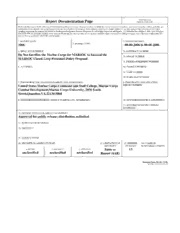
DTIC ADA509401: Do Not Sacrifice the Marine Corps for MARSOC to Succeed the MARSOC Closed Loop Personnel Policy Proposal
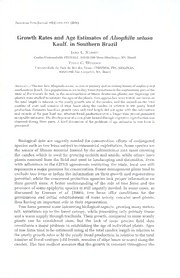
Growth Rates and Age Estimates of Alsophila setosa Kaulf. in Southern Brazil

The Beauty of Dusk: On Vision Lost and Found

by: tsegaye semere
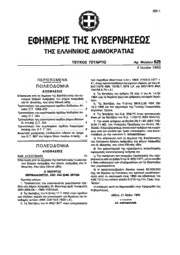
Greek Government Gazette: Part 4, 1993 no. 625

BY YEAR Expanded Advent Hymns

C. V. de Francisco Aguilar Piñal
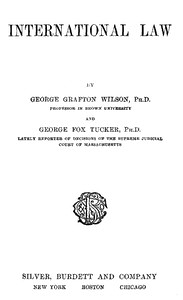
International Law by George Fox Tucker and George Grafton Wilson
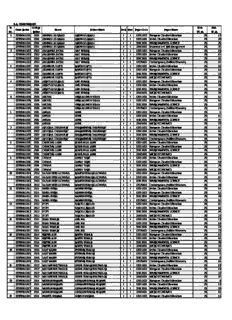
Sr. No. Exam Rollno College Rollno Name Father Name Part Sem Paper Code Paper Name Max
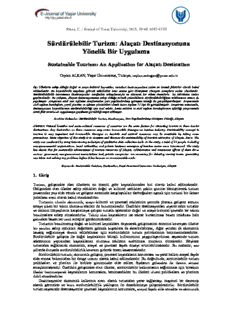
Sürdürülebilir Turizm
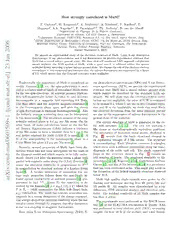
How strongly correlated is MnSi?
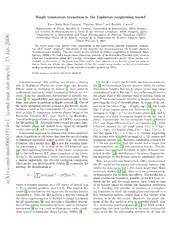
Single tensionless transition in the Laplacian roughening model
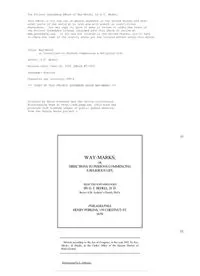
WayMarks or directions to persons commencing a religious life by G T Bedell D D

Greek Government Gazette: Part 4, 2006 no. 100
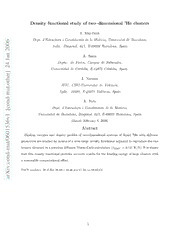
Density functional study of two-dimensional He-4 clusters

My Cheating Elf Girlfriend Collection 2: The Cuckold Comes Second Collection (Books 12-16)

